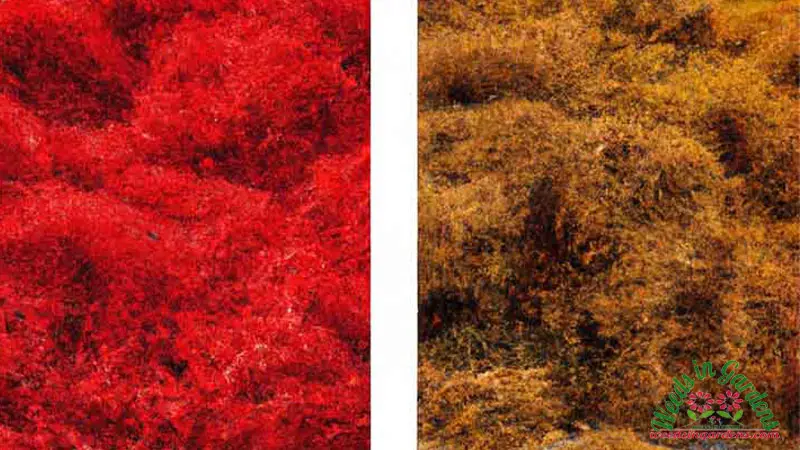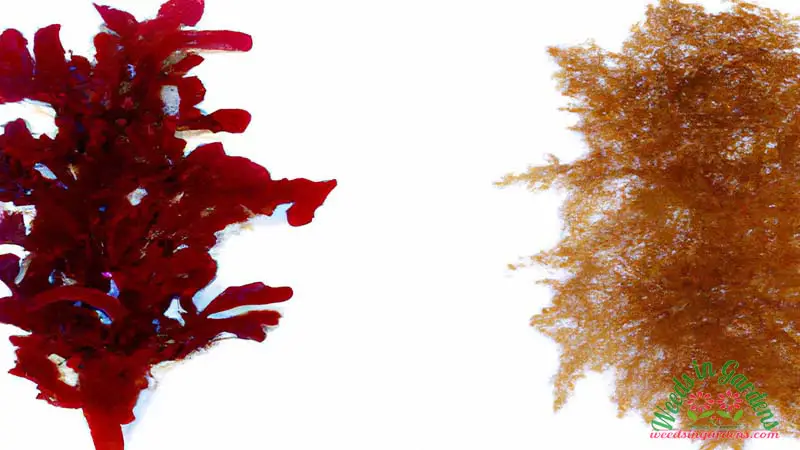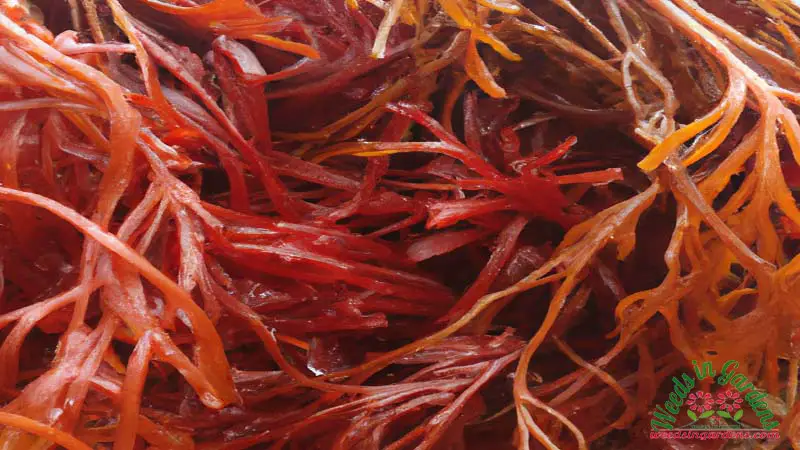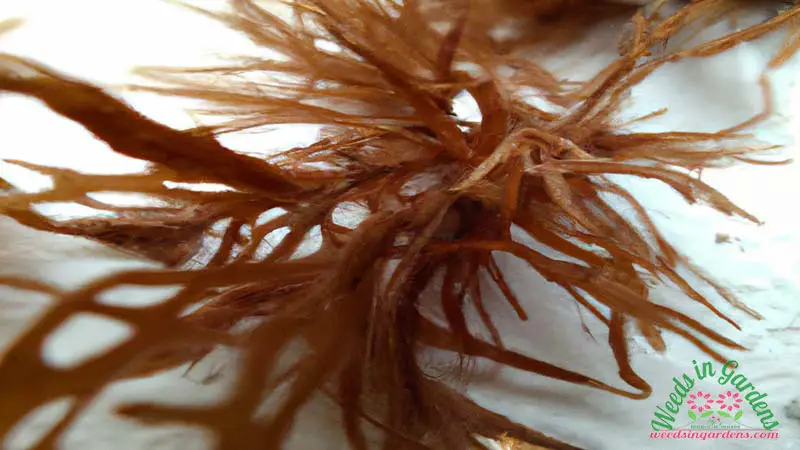Red algae and brown algae are two of the most well-known seaweed types commonly used for their health and wellness benefits. Although they are both found in the ocean and share some similar nutrients and benefits, there are distinct differences between red and brown algae.

Here, we will delve deeper into the key differences between red and brown algae.
- Structure and Appearance – Red algae have a simple, unbranched structure and are typically found in warmer waters. They have a reddish pigment that gives them their color. Brown algae, on the other hand, are larger and more complex in structure, with a branching appearance. They are found in colder waters and are brown in color.
- Nutrient Content – Both red and brown algae contain different nutrients, including vitamins, minerals, antioxidants, and polyphenols. However, the specific nutrient content of each type of algae varies. For example, red algae is a good source of Omega-3 fatty acids, while brown algae is rich in fiber and polyphenols.
- Health Benefits – Red algae and brown algae offer various health benefits, but there are some key differences. Red algae are mainly known for their heart-health benefits, while brown algae are known for their immune-boosting properties. Additionally, red algae are used in skin care products due to their ability to hydrate and nourish the skin, while brown algae are used for their hydration benefits.
- Culinary Uses – Both red and brown algae are used in food and drink products, but they are typically used in different ways. Red algae are commonly used as a natural food coloring, while brown algae are used as a thickener or stabilizer in food products.
- Taxonomy – Red algae are classified as Rhodophyta, while brown algae are classified as Phaeophyceae. This difference in classification highlights the distinct characteristics and properties of each type of algae.
- Reproduction – Red algae reproduce via sexual and asexual reproduction, while brown algae primarily reproduce via asexual reproduction through fragmentation.
- Cell Wall – The cell walls of red and brown algae differ in composition and structure. The cell walls of red algae contain carrageenan, which is utilized as a thickening agent for food products, while the cell walls of brown algae contain alginates, which are used as a thickener in cosmetics.
- Commercial Uses – Both red and brown algae are used commercially in a variety of industries, including food, cosmetics, and health supplements. However, each type of algae’s specific uses and applications vary, with red algae being used more frequently in cosmetics and skin care products, and brown algae being used more frequently in food products and supplements.
- Climate Requirements – Red algae are typically found in warmer waters. They are more sensitive to changes in water temperature and conditions, while brown algae are usually found in colder waters and are more tolerant of varying water conditions.
- Distribution – Red algae are found in all oceans and widely distributed worldwide, while brown algae are primarily found in temperate and colder waters. This difference in distribution is due to the unique adaptations of each type of algae to different water temperatures and conditions.
- Size – Red algae can range in size from single-celled microalgae to large, multi-celled seaweeds, while brown algae can grow to be very large, with some species reaching lengths of over 100 meters. This size variation results from different growth patterns and adaptations to different environments.
- Photosynthesis – Both red and brown algae perform photosynthesis but use different pigments to absorb light. Red algae use phycoerythrin and phycocyanin, while brown algae use fucoxanthin. This difference in pigments allows each type of algae to optimize its photosynthesis and energy production in different environments.
- Carbon and Energy Storage – Red algae store carbon and energy as starch, while brown algae store carbon and energy as laminarin. This difference in storage compounds reflects the unique metabolic processes and adaptations of each type of algae.
- Genetic Diversity – Red algae have a greater genetic diversity than brown algae. This difference in genetic diversity is likely due to the unique evolutionary history of each type of algae and its adaptations to different environments.
- Ecological Importance – Both red and brown algae play important roles in the marine ecosystem, but they have different impacts. Red algae provide habitat and food for a variety of marine organisms, while brown algae play a role in reducing the amount of carbon dioxide in the ocean through photosynthesis. This difference in ecological impact reflects the unique adaptations and properties of each type of algae and their role in the larger marine ecosystem.

Health Benefits of Red and Brown Algae
Support heart health – Both Red and brown algae are rich in Omega-3 fatty acids, which have been shown to support cardiovascular health and reduce the risk of heart disease.
Boost the immune system – They contain high levels of beta-carotene, a powerful antioxidant that helps to prevent oxidative damage and improve the immune system.
Promote healthy digestion – These algae are a natural source of fiber, which can help to regulate digestion and improve gut health.
Provide essential nutrients – Red and brown algae are a good source of vitamins B12, C, and E and minerals like iron, calcium, and magnesium.

Beauty Benefits of Red and Brown Algae
Improves skin health – Red and brown algae are known for their ability to hydrate and nourish the skin. They contain high levels of antioxidants, vitamins, and minerals that help to protect against environmental stressors and improve skin elasticity.
Reduce the appearance of wrinkles – The antioxidants and anti-inflammatory properties of red and brown algae make them effective ingredients for reducing the appearance of fine lines and wrinkles.
Promote hair growth – They contain high levels of iron, calcium, and magnesium, which are essential for promoting healthy hair growth.

How to Use Red and Brown Algae
Skincare products – Red and brown algae are commonly found in skin care products such as face creams, serums, and masks. Look for products that contain red/brown algae extract for maximum benefits.
Supplements – Red and brown algae supplements are available in capsule or powder form. These can be taken daily to support overall health and wellness.
Topically – They are applied topically to the skin and hair for added benefits. Try mixing red algae powder with water or coconut oil to create a nourishing mask.
Conclusion
Red and brown algae are two different types of seaweed that offer unique health and wellness benefits. Understanding the key differences between the two is important when choosing which one to incorporate into your diet or skincare routine. Whether you’re looking for heart-health benefits, immune-boosting properties, or skin hydration, red and brown algae are great options.
